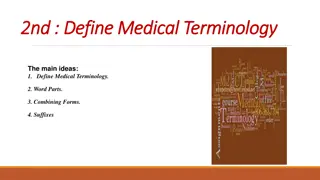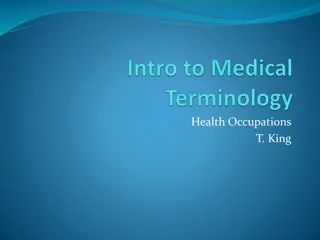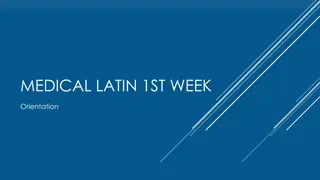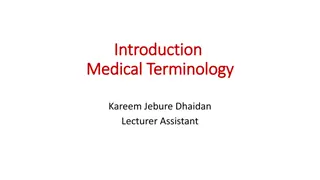Understanding the Structure of Medical Terms
Medical terms consist of word roots, prefixes, suffixes, and combining vowels rooted in Greek and Latin. Word roots provide the core meaning, prefixes modify it, suffixes indicate conditions, and combining vowels connect roots. Recognizing these elements aids in deciphering complex medical terminology. By starting with the suffix and understanding each component, you can break down and comprehend medical terms effectively.
Download Presentation

Please find below an Image/Link to download the presentation.
The content on the website is provided AS IS for your information and personal use only. It may not be sold, licensed, or shared on other websites without obtaining consent from the author. Download presentation by click this link. If you encounter any issues during the download, it is possible that the publisher has removed the file from their server.
E N D
Presentation Transcript
The parts that form medical terms include word roots, prefixes, suffixes and combining vowels. These parts have their origin in Greek and Latin. Word Root The word root is the main body of the word and helps with the fundamental meaning of the word. The word root will usually refer to body systems, organs, anatomy, diagnosis and medical procedures. A medical term can have more than one root. We will use the example word esophagogastroduodenoscopy. The suffix (-scopy) and the combining vowel (o) will be covered below.
Prefixes The prefix is placed before the word root to modify or vary the meaning. You will find that when the prefix is written detached it is commonly followed by a hyphen (-). The prefix (hyper-) means excessive or higher than normal. In the example below the prefix (hypo-) means below or lower than normal. The word root (volemia) means volume of plasma in the body or the condition of the volume of plasma in the body.
Suffixes The suffix is placed at the end of a word root or word part to modify or vary the meaning. Suffixes can indicate a condition, disease or a procedure. When a suffix is written detached it is preceded by a hyphen (-). This indicates that another word part precedes it. In the example below the suffix (-itis) means inflammation. The suffix (-scopy) means observation, visualization or examination. The word root (gastr) pertains to stomach.
Combining Vowel The combining vowel is usually an (o) which is often inserted between word roots to make a word easier to pronounce. Combining vowel usually connects one word root to another word root and also connects a word root to a suffix. The combining vowel does not modify or vary the meaning. When a word root is written with a combining vowel a forward slash is used. Example: esophag/o; gastr/o; duoden/o Example: esophagogastroduodenoscopy Try saying the word without the (o)!
Helpful Tips When you evaluate a medical term, begin at the end of the word with the suffix. Learn the individual parts of the medical term instead of trying to learn individual words. Most every medical term has a suffix. Remember that the word root(s) gives the fundamental meaning of the word. The combining vowel doesn t have a meaning but is used to connect more than one word root or a word root and suffix. A prefix is in the front A suffix is at the end A combining vowel is in the middle






















